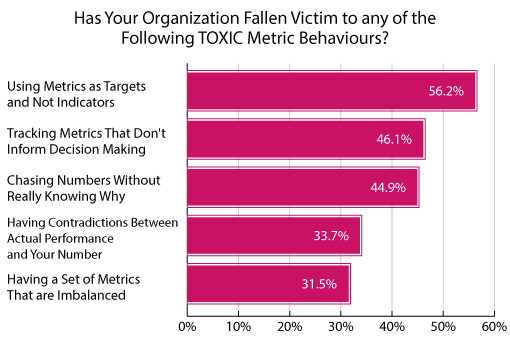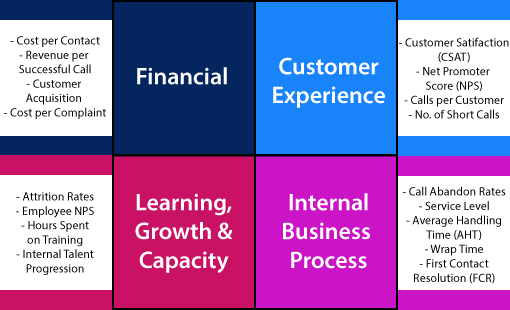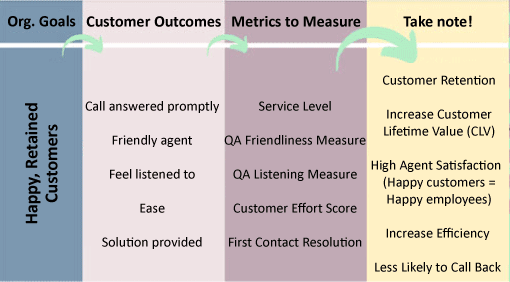We share examples of inbound call centre metrics and discuss how they are often misused, before sharing some much better practices.
What Are the Most Common Inbound Call Centre Metrics?
There are many metrics that inbound call centres use. Some of the metrics that you’ll most often find in inbound call centres are:
- Customer Satisfaction (CSAT) – This is a measure of how happy your customers are.
- Service Level – After setting a target for how quickly you answer a certain percentage of your calls, your service level tells you how close you are to that target.
- Complaint Volumes – Complaints are categorized and the category with the most complaints will help to show you where your most pressing problems lie.
- Average Handling Time (AHT) – This is the average length of telephone calls across the call centre. This is an important metric for staffing the call centre.
- Agent Satisfaction – This is a measure for how happy your call centre agents are.
- First Contact Resolution (FCR) – This inbound call centre metric is a percentage measure of how often a customer has to call back regarding the same problem.
- Schedule Adherence – Agents sticking to their schedule is key for hitting service levels, lowering call abandons and ensuring other agents don’t have too much to do. Schedule adherence is a percentage measure of how well agents do this.
- Quality Scores – Most inbound centres have quality scorecards, to check agents are doing the right things on calls. Analysts will listen to agents calls and use the scorecard to give individual agents their own quality scores.
- Forecast Accuracy – How good are you at predicting call volumes? Your forecast accuracy metric will tell you this.
- Call Abandon Rate – Are your queue times causing potential customers to walk away? Your call abandon rate will let you know.
It is one thing just to measure these inbound call centre metrics, it’s another to use them in a way that drives success across the call centre and wider business too.
So how can call centres make sure they are measuring the right things?
The first step is to avoid the five toxic metric behaviours highlighted below.
For more examples of inbound call centre metrics and what they represent, read our article: The Top 10 Most Important Call Centre Metrics
5 Toxic Inbound Call Centre Metric Habits to AVOID
Katie Stabler, Director of Customer Experience at the consultancy CULTIVATE, has identified five common traps that inbound call centres fall into when using metrics. These are:
- Using Metrics as Targets and Not Indicators – Don’t chase the number and forget about business, employee and advisor considerations in the process. Think about how you can improve your people, process and technology and let the improvements occur naturally.
- Tracking Metrics That Don’t Inform Decision-Making – If you have 20 inbound call centre metrics but you are only using two of them to actually change things within your operation, then what are the other 18 doing? They have to be there for a reason.
- Chasing Numbers Without Really Knowing Why – Why are you using a specific metric? What is it for? You need to know this so you can make effective changes and better align your department with the rest of the organization.
- Having Contradictions Between Actual Performance and Your Number – Are your quality scores and your customer satisfaction scores telling you different things? You need to question things like this when your scores aren’t quite adding up.
- Having a Set of Metrics That Are Imbalanced – Are you focusing so much on boosting one metric that you are neglecting other inbound call centre metrics and other key business indicators? This can lead to a whole host of problems.
These Bad Metric Habits Are Not Rare
Unfortunately, each of these five call centre metrics mistakes are often made by contact centres, with over half (56.2%) admitting to using metrics as targets and not indicators.

If you are one of the contact centres that has fallen into this trap – or any of the others that are presented in the chart above – it is likely time to review the metrics that you measure and maybe even adapt your overall approach to inbound call centre metrics.
So, how can you set about doing this?
Adopt the Balanced Scorecard Approach
One method to create a more systematic approach to how you use metrics in your inbound call centre is to adopt the Balanced Scorecard method.
The Balanced Scorecard was introduced by The Harvard Business Review in 1992 and is a tool that is still used by some organizations to translate strategic objectives into metrics that give you the right insights.
The tool divides inbound call centre metrics into four subsets. These include:
- Financial metrics
- Customer experience metrics
- Learning and growth metrics
- Internal business process metrics
To give you an example of how metrics can be divided into these subsets, the diagram below shows four sets of common metrics – and how they are categorized.

If you use a system like this to take a balanced approach to contact centre measurement, then you will likely have a similar number of metrics within each section of your scorecard.

However, don’t worry if you don’t. The key is to place equal emphasis on each section – not to have an equal number of metrics in each section. You must only measure what matters.
As Katie says: “You can have four financial metrics to match up with your four customer experience metrics, but if they are not actually doing much, what is the point in measuring them?”
So, go through your organizational and operational goals, create tangible outcomes and assess how you can measure those outcomes. Then divide up the metrics that you come up with across these four subsets.
The only pitfall that comes with this approach is that, when you are considering each of these four metric groups universally, it becomes harder to prioritize goals.
Think “Customer”
Of the four sets of inbound call centre metrics highlighted above, you may want to give a little more prominence to your customer experience metrics.
“The more your company’s attention is focused on outcomes important to your customers, the better your company will likely perform on outcomes important to the business,” says Katie.
In most cases, this is certainly true – but why?
Let’s say that we have a set of organizational goals. One may be to: “Generate happy, retained customers,” for example.
To meet this goal, you can set customer outcomes and measure your success through inbound call centre metrics – as shown in the diagram below.

What you will notice is that when you hit your outcomes and improve your targeted metrics, that will have a huge ripple effect across other metrics that you are not necessarily targeting.
For example, in the diagram above, we can see that when we achieve good results in our targeted inbound contact centre, we will also likely achieve:
- High Customer Satisfaction (CSAT) and improved Customer Effort Scores (CESs)
- High customer retention and increased Customer Lifetime Value (CLV)
- High employee advisor satisfaction rates and reduced staff turnover
- High Quality Assurance (QA) scores
- Low callback rates and call time
This is why putting a little more focus on your customer experience metrics can be so valuable within your inbound call centre metric stack.
You also want to consider how your customer outcomes are relayed to advisors. Do they know how their job influences the outcomes and customer experience metrics? This is an important consideration.
A good tip here, as our reader Jen suggests, is to: “Coach to the behaviour, not the metric.”
For more on this last point, read our article: 5 Important Call Centre Metrics to Improve Agent Performance
Collaboration With Other Departments
In the short video below, Katie Stabler presents another model for metrics – or key performance indicators (KPIs), as she refers to them – that will drive the success that you want.
In the video, Katie discusses the importance of the contact centre collaborating with other departments in how they set and measure certain organizational goals.
This is important, because everybody within your organization impacts many of your metrics in some way. Certainly in terms of your customer experience metrics, everybody needs to understand the metrics and know what they are working towards.
For more on customer experience metrics specifically, read our article: 10 Metrics to Help You Measure the Customer Experience
A Final Message
Let’s finish by reiterating a key point that Katie made earlier: “The more your company’s attention is focused on outcomes important to your customers, the better your company will likely perform on outcomes important to the business (i.e. your metrics).”
That is the key takeaway from this article, but we’ve also made lots of other key points regarding inbound call centre metrics.
So, to finish, here are three more key points to take back into your call centre:
- If you are guilty of any of the toxic metric behaviours that were presented in our first bar chart – STOP!
- Develop tangible customer outcomes from your organizational and operational goals and consider which metrics will help you to measure your progress in meeting those.
- Collaborate between different departments, so you all share the same customer experience metrics and are all pulling in the right direction.
For more advice on using inbound call centre metrics, read our articles:
- Contact Centre Benchmarking – How to Get More From Your Metrics
- Podcast: Is It Time to Rethink Your Call Centre Metrics?
- 10 Experts Share Their Favourite Advice on Call Centre Metrics
Author: Charlie Mitchell
Reviewed by: Robyn Coppell
Published On: 10th Feb 2021 - Last modified: 12th Jan 2026
Read more about - Call Centre Management, Agent Performance, Charlie Mitchell, Katie Stabler, Management Strategies, Metrics, Performance Management









































